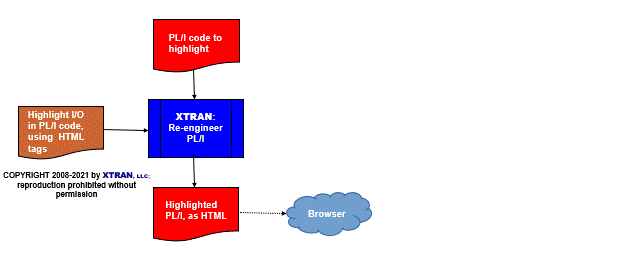XTRAN Example — Highlight File & Terminal I/O Code in PL/I, Display as HTML
The following example uses an XTRAN rules file comprising 166 non-comment lines of XTRAN's rules language ("meta-code") to highlight PL/I code involved with either file or terminal I/O, rendering the code as HTML for coloring.
These rules took about four hours to create and debug. (That's right, four hours!) They are not very specific to PL/I; they can easily be adapted to do the same for any 3GL language.
The rules use an XTRAN feature
called conditional decoration to highlight the
code. XTRAN also provides unconditional
decoration ![]()
![]() and code
nesting depth decoration
and code
nesting depth decoration
![]()
![]() .
.
Note that the rules infer file or terminal I/O usage of a variable to which a value is assigned that contains any variables of either type.
The following is an English paraphrase of the XTRAN rules used for this example:
Specify HTML as module rendering "decoration" prefix and suffix
Specify HTML as statement rendering "decoration" prefix and suffix,
according to statement's I/O involvement if any
Specify HTML as expression rendering "decoration" prefix and suffix,
according to expression's I/O involvement if any
For each PL/I statement
If DISPLAY or ACCEPT statement
Mark statement as "terminal I/O"
Mark all variables in statement as "terminal I/O"
Else if CLOSE, OPEN, READ, or WRITE statement
Mark statement as "file I/O"
Mark all variables in statement as "file I/O"
While variables to mark
For each PL/I statement
If assignment statement
If right side has "file I/O" and/or "terminal I/O" variables
If left side not already marked
Mark left side as such
Render code; XTRAN will decorate it as specified
How can such powerful code visualization be automated in only four hours and 166 lines of rules? Because there is so much capability already available as part of XTRAN's rules language. The rules used for this example take advantage of the following functionality provided by that rules language:
- "Per statement" recursive iterators
- "Per expression" recursive iterators
- Access to XTRAN's Internal Representation (XIR)
- XIR's language-independent properties
- Navigation in XIR
- Module decoration
- Conditional statement and/or expression decoration
- Creating new meta-functions written in meta-code, which we call user meta-functions
- Recursive user meta-functions
- Meta-variable and meta-function pointers
NOTE that the rendered code shown as XTRAN's output below was done with default conditions; XTRAN provides many options for controlling the way it renders code for output.
The input to and output from XTRAN are untouched.
Process Flowchart
Here is a flowchart for this process, in which the elements are color coded:
- BLUE for XTRAN versions (runnable programs)
- ORANGE for XTRAN rules (text files)
- RED for
code

Input to XTRAN:
prc: PROC (dspio1, filio1);
DCL (dspio1, dspio2) FIXED BIN (31);
DCL (filio1, filio2, filio3) FIXED BIN (31);
DCL (bthio1, bthio2) FIXED BIN (31);
DCL (neither1, neither2) FIXED BIN (31);
DCL file1 FILE;
DISPLAY ('First argument is ' || dspio1);
dspio2 = dspio1;
OPEN FILE(file1) INPUT TITLE('foo');
READ FILE(file1) INTO(filio1);
filio2 = filio1 + 1;
bthio1 = bthio1 + filio1;
neither1 = 1;
neither2 = neither1 + 1;
IF (filio2 > filio3) THEN
filio3 = filio2;
bthio1 = dspio1;
bthio2 = filio1 + bthio1;
dspio1 = neither2;
CLOSE FILE(file1);
RETURN;
END prc;